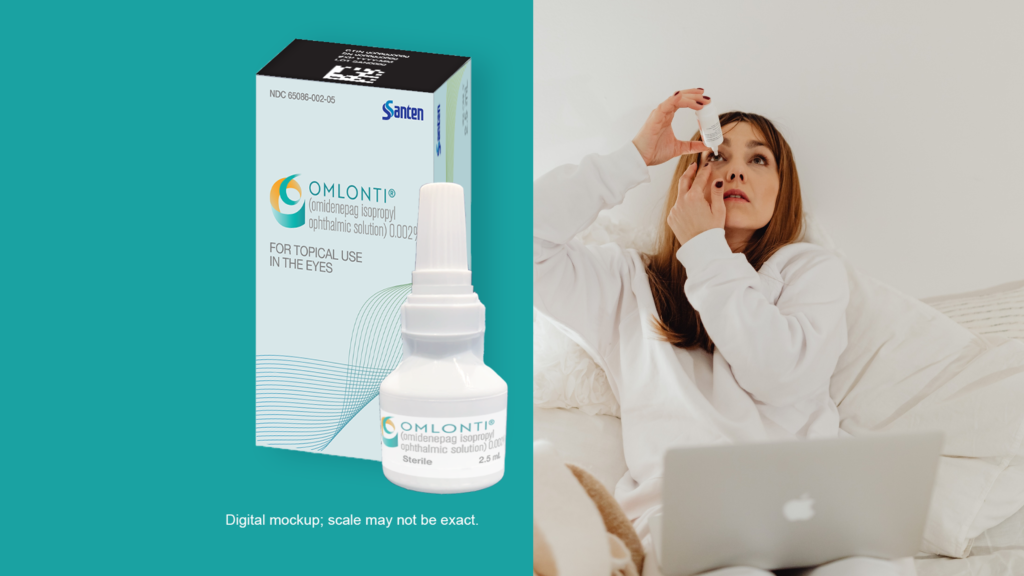Omlonti was approved by the US FDA for reducing elevated intraocular pressure (IOP) in patients with primary open-angle glaucoma or ocular hypertension.
Glaucoma is a group of progressive ocular diseases that cause damage to the optic nerve and resultant visual field loss and is the leading cause of irreversible blindness worldwide.
Open-angle glaucoma is the most common type of glaucoma and has no early-stage symptoms until people gradually notice blind spots in their peripheral vision. Eventually, it also affects the central vision. Ocular hypertension is one of the main causes of glaucoma, and it affects millions of people.
Since the occurrence of glaucoma increases with age, its global prevalence is increasing due to the aging population. In 2020, the number of people affected by glaucoma was estimated to be around 76 million, and it is expected to increase to over 111 million by 2040. Due to the progressive nature of the disease, early detection and treatment is crucial to avoid damaging the optic nerve — and lowering interocular pressure (IOP) is an effective method to manage the condition.
In Japan, an ophthalmic solution known as Eybelis was launched in November 2018 for managing elevated IOP, and subsequently filed for marketing approval in several more countries in Asia. Eventually, it was released in five countries beginning in February 2021.
On September 22, 2022, it was announced in a press release that the solution was approved as Omlonti by the US Food and Drug Administration (FDA) for reducing elevated IOP in patients with primary open-angle glaucoma or ocular hypertension.
Developed by companies Santen and UBE Corporation, the active ingredient in the eye drop solution is omidenepag isopropyl, a relatively selective prostaglandin EP2 receptor agonist. The solution increases drainage of the aqueous humour, the fluid produced by the eyes, through the trabecular and uveoscleral outflow pathways.
Omlonti is the only product currently available with this unique pharmacological mechanism of action, so its approval in the US is an important milestone for progressing eye health as it is the first glaucoma offering in the country.
XTALKS WEBINAR: Trials of Tomorrow: The Latest Technologies Advancing Dry Eye Disease Research
Live and On-Demand: Wednesday, October 12, 2022, at 11am EST (4pm BST/UK)
Register for this free webinar to learn how dry eye disease ophthalmic trials are embracing new technologies to accelerate programs and gain better insights into product efficacy.
Omlonti Reduces Intraocular Pressure and is Well-Tolerated in Clinical Trials
Three randomized and controlled double-masked clinical trials (1, 2, 3) were conducted to investigate the efficacy and safety of Omlonti. A total of 748 individuals over the age of 20 with open-angle glaucoma or ocular hypertension (with an average baseline IOP of 24 to 26 mm Hg) were recruited for the studies.
All three trials were three months in length, and one study included a nine-month open-label treatment period. In all three studies, IOP was reduced in the treatment arms. In the Omlonti arm, the IOP was reduced by 5 to 7 mm Hg in the three studies. The compared treatment arms, timolol and latanoprost, reduced the pressure by 5 to 7 and 6 to 8 mm Hg, respectively.
Additionally, the safety of Omlonti has been investigated in 12 clinical studies. The results from a large group of adult participants (n=1111) indicate that Omlonti is safe and well tolerated by adults diagnosed with open-angle glaucoma or ocular hypertension. Common side affects associated with the eye medication include macular edema in patients with risk factors for macular edema (for instance aphakia), ocular inflammation, possible increased eye pigmentation and changes in the eyelashes.
Current treatment options that target IOP reduction help prevent further vision loss in those with glaucoma or ocular hypertension. However, there is no one-size-fits-all solution for every patient, as they respond differently to each treatment and may not see any results with the options.
“The approval of omidenepag isopropyl ophthalmic solution 0.002% provides doctors with another safe and effective option to use when treating patients with these sight-threatening conditions,” said Jason Bacharach, MD, and Medical and Research Director at North Bay Eye Associates, Inc., in the press release.
Peter Sallstig, Chief Medical Officer of Santen, explained that by supporting patients affected by glaucoma and protecting their vision, they are shielded from potential social or economic opportunity loss that can be caused by vision loss. The approval of Omlonti is a significant step forward in vision care.








Join or login to leave a comment
JOIN LOGIN